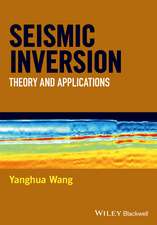Gravity Field, Seismicity and Tectonics of the Indian Peninsula and the Himalayas: Solid Earth Sciences Library, cartea 3
Autor R.K. Vermaen Limba Engleză Hardback – 31 iul 1985
| Toate formatele și edițiile | Preț | Express |
|---|---|---|
| Paperback (1) | 939.12 lei 43-57 zile | |
| SPRINGER NETHERLANDS – 26 sep 2011 | 939.12 lei 43-57 zile | |
| Hardback (1) | 788.11 lei 38-44 zile | |
| SPRINGER NETHERLANDS – 31 iul 1985 | 788.11 lei 38-44 zile |
Preț: 788.11 lei
Preț vechi: 1036.99 lei
-24% Nou
Puncte Express: 1182
Preț estimativ în valută:
150.82€ • 156.57$ • 125.76£
150.82€ • 156.57$ • 125.76£
Carte tipărită la comandă
Livrare economică 19-25 martie
Preluare comenzi: 021 569.72.76
Specificații
ISBN-13: 9789027718648
ISBN-10: 9027718644
Pagini: 236
Ilustrații: 228 p.
Ediția:1985
Editura: SPRINGER NETHERLANDS
Colecția Springer
Seria Solid Earth Sciences Library
Locul publicării:Dordrecht, Netherlands
ISBN-10: 9027718644
Pagini: 236
Ilustrații: 228 p.
Ediția:1985
Editura: SPRINGER NETHERLANDS
Colecția Springer
Seria Solid Earth Sciences Library
Locul publicării:Dordrecht, Netherlands
Public țintă
ResearchCuprins
1. Measurement of Gravity for Study of Figure of the Earth.- 1.1. Basic Concepts.- 1.2. Reduction of Gravity Data.- 1.3. General Remarks.- 2. Geology and Tectonics of Indian Peninsula.- 2.1. Introduction.- 2.2. Precambrians of Southern Peninsula.- 2.3. Eastern Ghats.- 2.4. Cuddapah Basin.- 2.5. Singhbhum in Bihar and Orissa.- 2.6. Satpura Orogenic Belt.- 2.7. Aravallis and Vindhyans.- 2.8. Precambrian of Madhya Pradesh.- 2.9. Gondwanas of Peninsular India.- 2.10. Earth Movements During Cretaceous and Eocene Times.- 2.11. Deccan Lavas.- 2.12. Formation of Indo-Gangetic Basin.- 2.13. Mountain Ranges and Plateaus of Peninsular India.- 3. Description of Bouguer and Free-Air Anomaly Maps of Peninsular India.- 3.1. Bouguer Anomaly Map.- 3.2. Major Trends on Bouguer Anomaly Map.- 3.3. Free-air Anomalies in Peninsular India.- 3.4. Inter-Relationship of Various Anomalies.- 4. Gravity Field and Tectonics of Gondwana Basins of Peninsular India.- 4.1. Introduction.- 4.2. Gravity Anomalies and Gondwana Tectonics.- 4.3. Geology of Gondwana Basins — General Remarks.- 4.4. Density of Gondwana Sediments.- 4.5. Godavari and Narmada — Son Valleys.- 4.6. Mahanadi Valley.- 4.7. Damodar Valley Coalfields.- 5. Gravity Field and its Relationship to Structures in Dharwar and Bastar Provinces of India.- 5.1. Introduction.- 5.2. Physiography.- 5.3. Geology of Dharwar Province.- 5.4. Gravity Field of Dharwar.- 5.5. Geological Implications of the Models.- 5.6. Gravity Field over Bastar Province.- 5.7. Nature of Upper Crust in the Archaean Terrain of South India.- 6. Gravity Field in the Eastern Ghats Belt.- 6.1. Geology of the Area.- 6.2. Gravity Field over Southern Granulite Terrain.- 6.3. Gravity Field over the Coastal Granulite Terrain.- 6.4. Nature of the Boundary Between Eastern Ghats andDharwar/Bastar Provinces.- 7. Analysis of Gravity Field Over Singhbhum and Adjoining Areas.- 7.1 Introduction.- 7.2. Geology of the Area.- 7.3. Observed Bouguer Anomaly Map.- 7.4. Interpretation of Major Anomalies in Terms of Two/Three Dimensional Models.- 7.5. Significance of Results in Terms of Geologic History of Singhbhum.- 8. Isostasy in Indian Peninsula.- 8.1. Historical Development of Isostasy in India.- 8.2. Various Schemes of Isostatic Compensation.- 8.3. Method of Computing Isostatic Anomaly.- 8.4. Isostatic Anomaly Map of Peninsular India.- 8.5. Depth of Compensation.- 9. Gravity Field and Isostasy in the Himalayas.- 9.1. Geology and Tectonics of the Himalaya.- 9.2. Geodetic Evidence for Prevalence of Isostasy.- 9.3. Gravity Field in the Himalaya.- 9.4. Gravity Traverses Across the Himalaya.- 9.5. Analysis of Results.- 9.6. Models for Isostatic Compensation.- 9.7. DSS Profile Across NW Himalaya.- 10. Satellite Gravity Field Over India and the Surrounding Regions.- 10.1. Introduction.- 10.2. Theoretical Background.- 10.3. Geoid Over India and the Surrounding Regions.- 10.4. Free-air Anomaly over India and the Surrounding Regions.- 10.5. General Remarks.- 11. Gravity Field and Seismicity in Northeastern India and Northern Burma.- 11.1. Introduction.- 11.2. Regional Geology and Tectonics.- 11.3. Bouguer Anomaly Map of Northeastern India.- 11.4. Pratt-Hayford Isostatic Anomaly Map of Northeastern India.- 11.5. Seismicity of NE India and N. Burma.- 11.6. Relationship Between Seismicity and Gravity Field in NE India and N. Burma.- 11.7. Plate Tectonics Model for Northeast India and N. Burma.- 12. Seismicity of the Himalayas and Plate Tectonics.- 12.1. Introduction.- 12.2. Geology and Tectonics of the Himalayas.- 12.3. Seismicity and its Relationship to Faults.- 12.4. Quantitative Seismicity.- 12.5. Focal Mechanism Solutions for the Himalayas.- 12.6. Orientation of P Axes.- 12.7. Models for the Evolution of the Himalayas.- Author Index.
























